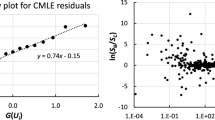Abstract
The central problem in the quantum theory of measurement, how to describe the process of state reduction in terms of the quantum mechanical formalism, is solved on the basis of the relativity of quantal states, which implies that once the apparatus is detected in a well-defined state, the object state must reduce to a corresponding one. This is a process termed by Schrödinger disentanglement. Here, it is essential to observe that Renninger's negative result does constitute an actual measurement process. From this point of view, Heisenberg's interpretation of his microscope experiment and the Einstein-Podolsky-Rosen arguments are reinvestigated. Satisfactory discussions are given to various experimental situations, such as the Stern-Gerlach-type experiment, successive measurements, macroscopic measurements, and Schrödinger's cat. Finally it is proposed to regard a state vector in quantum mechanics as an irreducible physical construct, in Margenau's sense, that is not further analyzable both mathematically and conceptually.
Similar content being viewed by others
References
N. Bohr,Atomic Physics and Human Knowledge (John Wiley, New York, 1958); W. Heisenberg,Die Physikalischen Prinzipien der Quantentheorie (Hirzel, Leipzig, 1930).
J. von Neumann,Mathematische Grundlagen der Quantenmechanik (Springer-Verlag, Berlin, 1932).
J. M. Jauch, E. P. Wigner, and M. M. Yanase,Nuovo Cimento 48B, 144 (1967).
H. P. Krips, Suppl.Nuovo Cimento 6, 1127 (1968).
E. P. Wigner,Am. J. Phys. 31, 6 (1963).
A. Einstein, B. Podolsky, and N. Rosen,Phys. Rev. 47, 777 (1935).
E. Schrödinger,Proc. Cambridge Phil. Soc. 31, 555 (1935).
H. Margenau,Phys. Rev. 49, 240 (1936).
N. Bohr,Phys. Rev. 48, 696 (1935).
W. Heisenberg,Z. Physik 43, 172 (1927).
P. A. M. Dirac,Sci. Am. 208, No. 5, 45 (1963).
B. S. DeWitt,Battelle Rencontres, C. M. DeWitt and J. A. Wheeler, eds. (Benjamin, New York, 1968), p. 318.
M. Born,Z. Physik 38, 803 (1926).
M. Renninger,Z. Physik 158, 417 (1960).
H. Margenau,Phil. Sci. 25, 23 (1958).
I. Fujiwara,Progr. Theoret. Phys. (Kyoto) 44, 1701 (1970).
E. Schrödinger,Naturwissenschaften 23, 823 (1935).
H. Everett,Rev. Mod. Phys. 29, 454 (1957).
J. McKnight,Phil. Sci. 24, 321 (1957).
W. H. Furry,Phys. Rev. 49, 393 (1936).
E. Schrödinger,Nuovo Cimento 1, 5 (1955).
W. Heisenberg, Theory, criticism and philosophy, inFrom a Life of Physics (IAEA, Vienna).
H. Margenau,Rev. Mod. Phys. 13, 176 (1941).
Author information
Authors and Affiliations
Rights and permissions
About this article
Cite this article
Fujiwara, I. Quantum theory of state reduction and measurement. Found Phys 2, 83–110 (1972). https://doi.org/10.1007/BF00708495
Received:
Issue Date:
DOI: https://doi.org/10.1007/BF00708495




